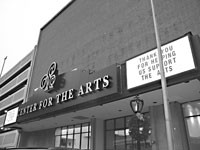Before it became the Center for the Arts, the old Masonic Temple downtown on Sixth Street was labyrinthine, ugly and outdated. Its bland, dreary innards were a metaphor for Springfield's cultural life, especially its downtown cultural life.
But finally, someone did something about it. Thanks to a $8.2 million renovation that took place throughout the year, the CFA has become smart, stylish, open -- even state-of-the-art. After a Dec. 15 ribbon-cutting ceremony, it hit home for many in the arts community: They finally have a place downtown.
"A big turning point was at the [ceremony]," says Leigh Ann Smith, president of the Theatre Centre's board. "It was the first time I had been there in two months. It was a really good turnout. I thought to myself, 'Wow! This is going to be a reality.' "
So far, at least 11 arts organizations have promised to either move into the center or rent space there. Its biggest tenant will be the Springfield Theatre Centre. For about $4,000 a month, the Centre gets rooms for offices, rehearsals, auditions, storage and set designing. It also gets first dibs for the use of Theater 1, which seats at least 500, has dressing rooms and an orchestra pit.
The center has three theaters as well as a few reception-type areas, a gallery, a board room, a dining room that can seat about 400 guests, and numerous office spaces. Other groups that plan to rent there include the Prairie Art Alliance, St. Andrews Society, Sangamon Watercolor Society, Sangamon Valley Youth Symphony, Springfield Area Arts Council, the Land of Lincoln Barbershop Chorus, Springfield Ballet Company, Springfield Celebration Sound Chorus, Springfield International Folk Dancers, and Springfield Muni Opera.
To say that the CFA needs the Springfield Theatre Centre most of all is an understatement. The CFA's board of trustees -- who set up the CFA as a private, nonprofit entity -- figured they could pay for the building's expenses by leasing out space to arts organizations as well as private groups holding wedding receptions, parties, conferences, and concerts. They're also trying to raise an endowment to subsidize events promoted by groups that don't have enough money to pay the center's rates. The Theatre Centre's rent makes up nearly 25 percent of estimated annual operating expenses, according to Loren Barnes, CFA building manager. Some of the other groups will pay as little as $10 a month for use of the building.
While the Theatre Centre has made it clear that its new home will be the CFA, there are reservations. Everyone wants the CFA to be a success, but no community arts group wants to lose whatever hard-fought ground it spent decades gaining.
As many benefits as the CFA offers the community theater -- more parking and seats, better box office services, and the opportunity to create dinner packages with downtown restaurants down the block -- there are still some mixed feelings about moving. "There's a lot of nervousness," Smith says.
The Theatre Centre is only a few months away from completing the mortgage on its long-time home at 101 E. Lawrence Ave. There's still some debate about what to do with it. Some of the board members want to sell it and apply the cash toward rent at the CFA; some would like to keep it and use it as a children's theater workshop. It's yet to be determined whether the theater's stage drapes and lighting system -- valued at about $100,000 -- will move with it to the CFA or stay put. There was initially talk of the CFA buying them from the Theatre Centre, but both sides say negotiations are ongoing. Renovation delays have already pushed the Theatre Centre's CFA debut back a year. While Smith says she can't wait for the first scheduled performance next September there, of Sunday at the Park with George, a production they can't do at their current home, there's a sense of keeping the old building close at hand.
"In the back of our minds if things don't work out . . .," Smith says.
Smith's hesitation is understandable. There's been a steady quest to locate a downtown arts center ever since the late 1970s, the dawn of downtown revitalization in Springfield. Arts leaders have been waiting a long time for something like this. "Now that it's here, the new facility is a little overwhelming," Smith says.
Downtown developer Carolyn Oxtoby and others have long thought about buying the temple but the Masons were never interested in selling, until recently when their shrinking ranks could no longer afford to keep up their 80,000 square-foot home, which was built in 1909 and expanded in the 1960s.
A group of local community leaders got together, and with a $350,000 donation from Oxtoby and her brother Stephen Bartholf, purchased the building in 2001. The state provided a $5.5 million construction grant and Sangamon County loaned the group another $2 million in bonds. Additional funds have come from the City of Springfield's downtown TIF district and private donations.
The CFA will gets its first official trial during First Night on New Year's Eve, which it will host. It's likely none of the 11 groups will have moved in by then, Barnes says. But the building's schedule is already filling up. Theater 1 has events planned through May. And the center is working on allowing WUIS/WSEC public radio to store equipment there for live broadcasts.
In fact, the trustees have had contact with so many different groups interested in securing space at the CFA that "they're seriously considering a moratorium for bringing in anything new to keep it from being over-committed," Barnes says.
These are the best kinds of problems, according to Christine Ramirez-Campbell, executive director of the Springfield Area Arts Council, a future CFA tenant. Ramirez-Campbell is also co-chair of the CFA's building board, which represents tenants there.
"None of us, as smaller arts organizations, could ever dream of having such a facility. We all tend to be territorial but everyone is supercharged about the collaboration possibilities," Ramirez-Campbell says. "We want to learn to be good neighbors. So far everyone has a cooperative spirit."
Ramirez-Campbell says the SAAC will pay about $300 a month plus utility expenses for office space at the CFA. "Three-hundred a month is unheard of downtown," she says. "The Prairie Art Alliance will be tripling its space."
Ramirez-Campbell says what the CFA offers Springfield is ultimately a place that rivals any space a much larger city can offer. "What would the rent be in Chicago or St. Louis at a similar arts center?" she asks. "But to maintain such a building takes a big commitment. We know we all have to be committed to sustaining it."
That's where the rest of us come in. During the ribbon cutting four Springfield mayors took the stage, as did Illinois House Speaker Michael Madigan, who was instrumental in securing the state grant, and Sangamon County Circuit Court Judge Thomas Appleton, the CFA's president.
No one from the arts community joined the politicians on stage during the ceremony -- and they weren't asked to either. True, politicians helped build the center. But the artists need to charge the stage.
The rest of us have the easiest job. All we need to do is fill the seats and clap.



















